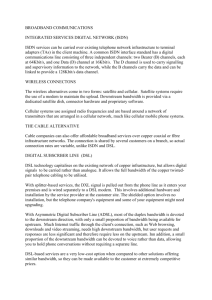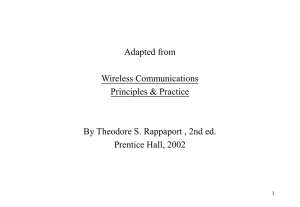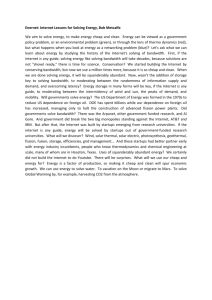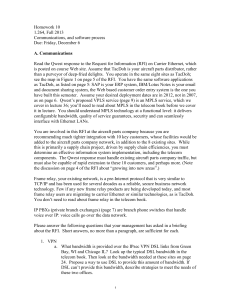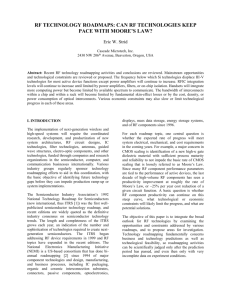University of the Aegean
advertisement
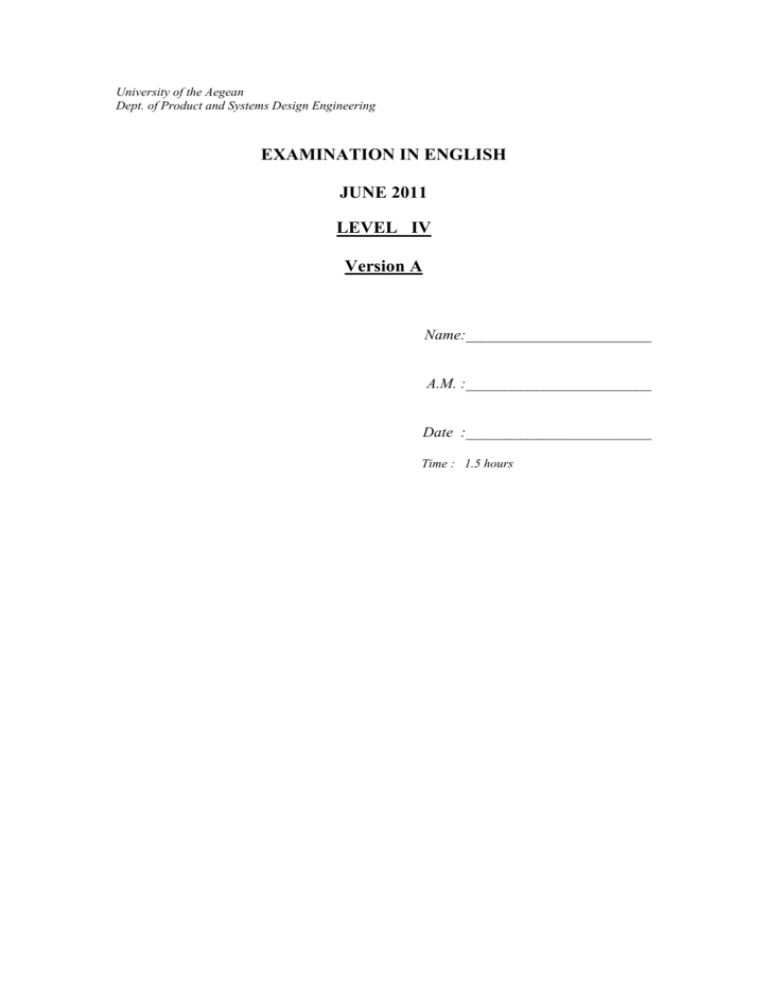
University of the Aegean Dept. of Product and Systems Design Engineering EXAMINATION IN ENGLISH JUNE 2011 LEVEL IV Version A Name:________________________ A.M. :________________________ Date :________________________ Time : 1.5 hours A. Read the following text titled “Broadband Communications” and answer the question in your own words, as briefly as possible: Explain how satellite systems work. What equipment is involved in this process? __________________________________________________________ 2 ps. [N.B.: Mere copying of part(s) of the text will NOT take ANY credits!! Also, any irrelevant or unnecessary information in your answer will be penalized!] BROADBAND COMMUNICATIONS Integrated Services Digital Network (ISDN) ISDN services can be carried over existing telephone network infrastructure to terminal adapters (TAs) in the client machine. A common ISDN interface standard has a digital communications line consisting of three independent channels: two Bearer (B) channels, each at 64Kbit/s, and one Data (D) channel at 16Kbit/s. The D channel is used to carry signalling and supervisory information to the network, while the Β channels carry the data and can be linked to provide a 128Kbit/s data channel. Wireless connections The wireless alternatives come in two forms: satellite and cellular. Satellite systems require the use of a modem to maintain the upload. Downstream bandwidth is provided via a dedicated satellite dish, connector hardware and proprietary software. Cellular systems use assigned radio frequencies and are based around a network of transmitters that are arranged in a cellular network, much like cellular mobile phone systems. The cable alternative Cable companies can also offer affordable broadband services over copper coaxial or fibre infrastructure networks. The connection is shared by several customers on a branch, so actual connection rates are variable, unlike ISDN and DSL. Digital Subscriber Line (DSL) DSL technology capitalises on the existing network of copper infrastructure, but allows digital signals to be carried rather than analogue. It allows the full bandwidth of the copper twisted-pair telephone cabling to be utilised. With splitter-based services, the DSL signal is pulled out from the phone line as it enters your premises and is wired separately to a DSL modem. This involves additional hardware and installation by the service provider at the customer site. The shielded option involves no installation, but 1 the telephone company's equipment and some of your equipment might need upgrading. With Asymmetric Digital Subscriber Line (ADSL), most of the duplex bandwidth is devoted to the downstream direction, with only a small proportion of bandwidth being available for upstream. Much Internet traffic through the client's connection, such as Web browsing, downloads and video streaming, needs high downstream bandwidth, but user requests and responses are less significant and therefore require less on the upstream. In addition, a small proportion of the downstream bandwidth can be devoted to voice rather than data, allowing you to hold phone conversations without requiring a separate line. DSL-based services are a very low-cost option when compared to other solutions offering similar bandwidth, so they can be made available to the customer at extremely competitive prices. B. Fill in the blanks in the following sentences with a suitable word or phrase from the text above in the right form. Add any necessary words (such as prepositions, etc.). 1. This program was launched in order to increase the _______________ of women and coloured people in the police service. No smoking is allowed on the University ______________ . 2. 2 ps. C. Find a suitable word or phrase in the text above for the definitions below. 1. [n.] The signal path for receiving communications from a client computer to a server in a network: _______________________________ [adj.] a) Goods made and sold by a particular company and protected by a registered trademark; b) relating to an owner or to the fact of owning sth.: _______________________________ [n.] The basic systems and services that are necessary for a country or an organization to work properly, for example transport, water and power supplies and administrative systems: _______________________________ 2. 3. 3 ps. 2 D. Transcribe the following words from phonetic script (they are all in the text above). 1. / 2. / 3. / 4. / /: __________________________ /: __________________________ /: __________________________ /: __________________________ 2 ps. E. Look at the list of terms and technical expressions which are related to the Bluetooth technology or Communications in general and select the most appropriate one for the following definitions/descriptions. connectivity wireless link system portable equipment amplifier error-free operation usable density wireless link system modulation technique 1. 2. 3. 4. 5. packet-switching protocol transmission power bandwidth spread spectrum piconet unlicensed band encryption collision detection access point brainchild fully-fledged asymmetric duplex hopping royalty-free conflicting signal speed of response The range of frequencies that can be transmitted over a communications channel: ______________________________________ The process or mechanism of determining whether two devices, shapes, etc. are partially occupying the same space with the aim of preventing simultaneous operation or overlapping: ______________________________________ Fast and constant shifting from one state to another, one radio wave to another, one channel to another, etc.: ______________________________________ A set of very small low power wireless links consuming the smallest unit of current (i.e. a pA) that are set up between Bluetooth devices when they are within 10 metres of each other: ______________________________________ A form of electromagnetic communication in which the signal frequency or bandwidth expands beyond that required, rendering it more difficult to intercept or jam, or to send multiple signals over the same band: ______________________________________ 5 ps. 3 F. Find the words for the following definitions. They refer to technological issues and advances. The first letter is given. 1. [n.] A device that detects certain external stimuli, such as light, heat, pressure, etc and reacts to them in order to make a machine or other equipment do sth. or show sth.: S _______________________________ [adj.] (of a mechanism) Moved or operated by the pressure of water or other liquid: H _______________________________ [n.] A piece of equipment that measures and shows the level, speed, temperature, etc of sth, e.g. a heart ∼ / a noise ∼: M _______________________________ 2. 3. 3 ps. G. Scissors are first order levers. Briefly explain why, using the appropriate technical terms. (In other words, mention the three main parts of such mechanisms and their position in relation to one another.) _______________________________________________________________ 3 ps. H. Name the tools depicted in the pictures below. 1. ____________________________________ 4 2. ____________________________________ 3. ____________________________________ 3 ps. I. Find the words for the following definitions. They either refer to types of metals or other materials, or describe certain properties of metals and other materials. Give a noun or an adjective form according to what is indicated in the beginning. (Note: the first letter is given for some of them) 1. [n.] The type of plastic which remains rigid and retains its shape at high temperatures; however, it can NOT undergo treatment more than once or it will be damaged; e.g. resin, melamine, urea formaldehyde: a(n) _____________________ _______________________ [n.] A substance or material which will not transmit electricity or heat (i.e. a material which does not allow heat or current to flow easily), e.g. urea formaldehyde: a(n) _____________________ 2. 5 3. 4. [adj.] Describes materials which are not destroyed by chemical action caused for example by acids, salt, etc., e.g. stainless steel, aluminium, copper: c_____________________ - r_______________________ [n.] The type of metal which is formed by other metals and / or elements; not pure, e.g. brass, steel: a(n) _____________________ 4 ps. J. Express the following numbers, fractions, mathematical symbols, symbols for measurement, and time in words. N.B.: a) if any of the numbers is expressed differently in British and American English, either would be acceptable provided you indicate which language you are using! b) the word for ‘0’ in the decimal fractions can be omitted – however, for the purpose of this exercise you are asked to write it! c) the abbreviated forms “a.m.” or “p.m.” should also be expressed in words!! 1. 2. 3. [cardinal no] [ordinal no.] [vulgar fraction] 12.833.040 430th :________________________________ :________________________________ :________________________________ ⅜ 3 ps. GOOD LUCK!!! 6
